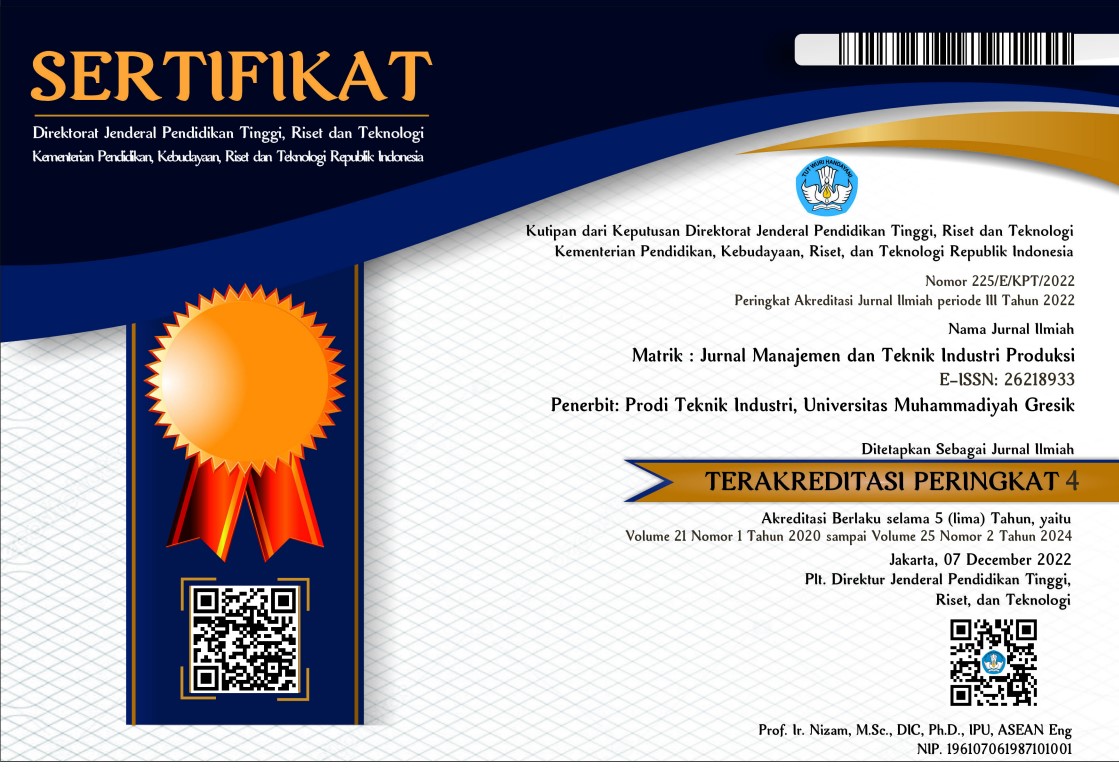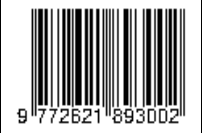Analisis Strategi Pemasaran Bio-Oil Di Kabupaten Sumenep
DOI:
https://doi.org/10.30587/matrik.v23i2.4931Keywords:
Bio mass, bio oil, IFAS, EFAS, SWOT, QSPMAbstract
Meningkatnya pertumbuhan populasi sangat berpengaruh besar terhadap aspek permintaan suatu produk dan menyebakan tekanan secara eksponensial dari sumber daya alam yang digunakan. kisaran konsumsi minyak di Indonesia yaitu berada pada 1.398.496 (barel/day.th) sampai 1.611.599 (barel/day.th), dimana Indonesia termasuk kedalam 10 besar negara dengan penggunaan terbanyak. menciptakan produk alternative yang memiliki kualitas baik , mendaur ulang limbah sebagai bahan baku, atau peningkatan teknologi yang mengurangi jumlah input,serta startegi pemasaran yang tepat dalam pengenalan produk baru atau produk inovatif. Salah satu energi alternatif yaitu bio-oil. Pemasaran bio-oil masih terbatas dan sangat kurang khususnya di kabupaten sumenep. Hal ini banyaknya masyarakat yang belum mengetahui bio-oil dan juga belum memahami pentingnya energi terbarukan sebagai perngganti energi dari bahan bakar fosil. Pada penelitian ini strategi pemasaran bio-oil dilakukan dengan menggunakan analisis SWOT (Strengths Weakness Opportunities Threats), strategi yang tepat digunakan adalah agresif (growth oriented strategy) dimana mengembangkan kekuatan dari faktor internal(s-w/2=0,24; o-t/2=0,39) dan peluang dari faktor eksternal serta penggunaan matriks QSPM, penetrasi pasar (Tas=6,84) menjadi pilihan utama untuk memaksimalkan strategi yang diterapkan
References
[2] R. R. Amin, R. R. Sova, D. I. Laily, and D. K. Maharani, “Studi Potensi Limbah Tembakau Menjadi Bio-Oil Menggunakan Metode Fast-Pyrolysis Sebagai Energi Terbarukan,” J. Kim. Ris., vol. 5, no. 2, p. 151, 2020.
[3] A. Doshi, S. Pascoe, L. Coglan, and T. J. Rainey, “The value of externalities for biofuels and implications for policy-led development : A discrete choice experiment with Australian consumers,” Sustain. Prod. Consum., vol. 35, pp. 592–604, 2023.
[4] A. Pakseresht, A. Yavari, S. A. Kaliji, and K. Hakelius, “The intersection of blockchain technology and circular economy in the agri-food sector,” Sustain. Prod. Consum., vol. 35, pp. 260–274, 2022.
[5] L. Niessen, N. M. P. Bocken, and M. Dijk, “The impact of business suf fi ciency strategies on consumer practices : The case of bicycle subscription,” Sustain. Prod. Consum., vol. 35, pp. 576–591, 2023.
[6] S. Xu and J. Ge, “Sustainable development of clean heating in rural northern China : Locally tailored energy options,” Sustain. Prod. Consum., vol. 35, pp. 655–667, 2023.
[7] E. Ortiz-Martínez, S. Marín-Hernández, and J. M. Santos-Jaén, “Sustainability, corporate social responsibility, non-financial reporting and company performance: Relationships and mediating effects in Spanish small and medium sized enterprises,” Sustain. Prod. Consum., vol. 35, pp. 349–364, 2023.
[8] H. Zhen et al., “Solutions to neutralize greenhouse gas emissions of the rice value chain — A case study in China,” Sustain. Prod. Consum., vol. 35, pp. 444–452, 2023.
[9] H. Roberts, L. Milios, O. Mont, and C. Dalhammar, “Product destruction: Exploring unsustainable production-consumption systems and appropriate policy responses,” Sustain. Prod. Consum., vol. 35, pp. 300–312, 2023.
[10] M. Eriksson, J. Christensen, and C. Malefors, “Making food waste illegal in Sweden – Potential gains from enforcing best practice in the public catering sector,” Sustain. Prod. Consum., vol. 35, pp. 229–237, 2022.
[11] J. Li, R. R. Z. Tarpani, L. Stamford, and A. Gallego-Schmid, “Life cycle sustainability assessment and circularity of geothermal power plants,” Sustain. Prod. Consum., vol. 35, pp. 141–156, 2023.
[12] T. Pilevneli, G. Capar, and C. Sánchez-cerdà, “Investigation of climate change impacts on agricultural production in Turkey using volumetric water footprint approach,” Sustain. Prod. Consum., vol. 35, pp. 605–623, 2023.
[13] T. Ding, L. Fang, J. Chen, J. Ji, and Z. Fang, “Exploring the relationship between water-energy-food nexus sustainability and multiple ecosystem services at the urban agglomeration scale,” Sustain. Prod. Consum., vol. 35, pp. 184–200, 2023.
[14] K. Molina-Besch and H. Keszleri, “Exploring the industrial perspective on biobased plastics in food packaging applications – Insights from Sweden,” Sustain. Prod. Consum., vol. 35, pp. 72–84, 2023.
[15] L. Zhao, Y. Lv, C. Wang, J. Xue, Y. Yang, and D. Li, “Embodied greenhouse gas emissions in the international agricultural trade,” Sustain. Prod. Consum., vol. 35, pp. 250–259, 2022.
[16] W. Van Opstal and A. Smeets, “Circular economy strategies as enablers for solar PV adoption in organizational market segments,” Sustain. Prod. Consum., vol. 35, pp. 40–54, 2023.
[17] K. K. T. M, S. Pal, P. Chand, and A. Kandpal, “Carbon sequestration potential of sustainable agricultural practices to mitigate climate change in Indian agriculture : A meta-analysis,” Sustain. Prod. Consum., vol. 35, pp. 697–708, 2023.
[18] I. D’Adamo, M. Ribichini, and K. P. Tsagarakis, “Biomethane as an energy resource for achieving sustainable production: Economic assessments and policy implications,” Sustain. Prod. Consum., vol. 35, pp. 13–27, 2023.
[19] F. Febriyanti, N. Fadila, A. S. Sanjaya, Y. Bindar, and A. Irawan, “Pemanfaatan Limbah Tandan Kosong Kelapa Sawit Menjadi Bio-Char, Bio-Oil Dan Gas Dengan Metode Pirolisis,” J. Chemurg., vol. 3, no. 2, p. 12, 2019.
[20] M. J. Akbar, Q. Qurtubi, and M. F. N. Maghfiroh, “Perancangan strategi pemasaran menggunakan metode swot dan qspm untuk meningkatkan penjualan beras,” J. INTECH Tek. Ind. Univ. Serang Raya,vol. 8, no. 1, pp. 61–67, 2022.
[21] A. Hendrawan, H. Sucahyowati, and T. Laras, “Analisis Strategi Pemasaran Dengan Pendekatan Marketing Mix,” Manaj. dan Ekon., vol. 3, no. 1, pp. 55–72, 2020
[22] W. Widiyarini and Z. F. Hunusalela, “Perencanaan Strategi Pemasaran Menggunakan Analisis SWOT dan QSPM dalam Upaya Peningkatan Penjualan T Primavista Solusi,” JABE (Journal Appl. Bus. Econ., vol. 5, no. 4, p. 384, 2019, doi: 10.30998/jabe.v5i4.4186.
[22] E. Permata et al., “Analisa Strategi Pemasaran Dengan Metode BCG (Boston Consulting Group) dan Swot,” SITEKIN J. Sains, Teknol. dan Ind., vol. 17, no. 2, pp. 92–100, 2020, Accessed: Aug. 25, 2021.
[23] M. Rizki et al., “Determining Marketing Strategy At LPP TVRI Riau Using SWOT Analysis Method,” J. Appl. Eng. Technol. Sci., vol. 3, no. 1, pp. 10–18, 2021.
[24] A. Efendi, M. Rizki, F. S. Lubis, and M. I. Hadiyul, “An Analysis of the Crispy Mushroom Business For Small And Medium-Sized Enterprises (SMEs) In Indonesia,” 2022.
[25] M. Rizki et al., “Aplikasi End User Computing Satifaction pada Penggunaan E-Learning FST UIN SUSKA,” SITEKIN J. Sains, Teknol. dan Ind., vol. 19, no. 2, pp. 154–159, 2022, Accessed: Jun. 05,
[26] Suparyanto dan Rosad (2015, “済無No Title No Title No Title,” Suparyanto dan Rosad (2015, vol. 5, no. 3, pp. 248–253, 2020.
[27] A. Nurul Sabry, “Rumusan Strategi Pemasaran Dalam Penjualan Produk Dengan Metode Swot Dan Qspm (Quantitative Strategic Planning Matrix) (Studi Kasus Cv. Bimanda Elektronik Pekanbaru),”J. Surya Tek., Vol. 7, No. 1, Pp. 118–129, 2020, Doi: 10.37859/Jst.V7i1.2359.
[28] W. G. A. Luntungan and H. N. Tawas, “Strategi Pemasaran Bambuden Boulevard Manado: Analisis Swot,” J. Emba J. Ris. Ekon. Manajemen, Bisnis Dan Akunt., Vol. 7, No. 4, Pp. 5495–5504, 2019.
[29] I. Prayudi, P. Wisnubroto, and J. Susetyo, “Analisis Strategi Pemasaran Eva Boutique Dengan Metode Swot Dan Qspm,” J. Rekavasi, Vol. 7, No. 1, Pp. 33–40, 2019.
[30] H. Hamdani, W. Wahyudin, and C. G. G. Putra, “Analisis Pengendalian Kualitas Produk 4l45w 21 .5 My Menggunakan Seven Tools Dan Kaizen,” Go-Integratif J. Tek. Sist. Dan Ind., Vol. 02, No. 02, Pp. 112–123, 2021.







